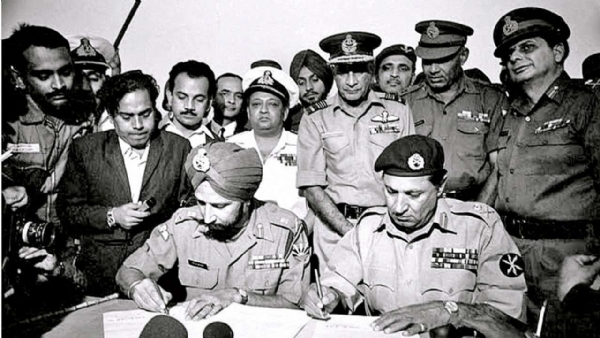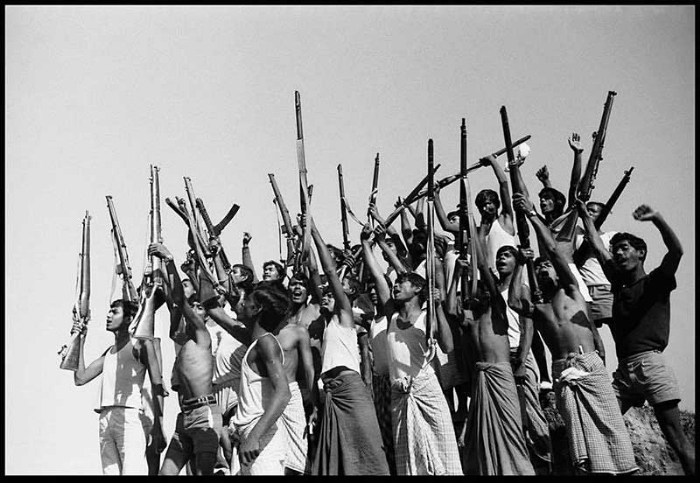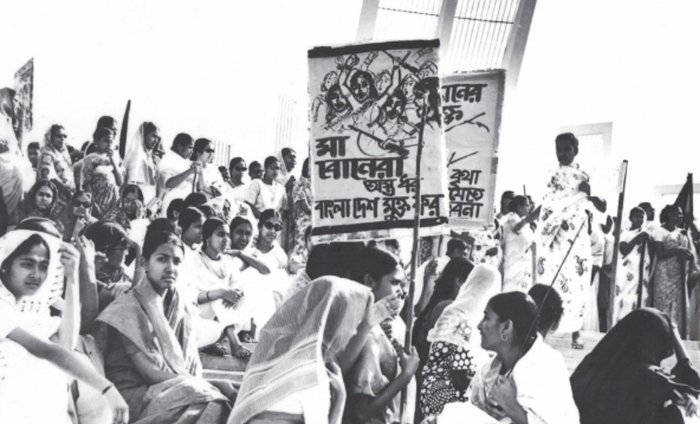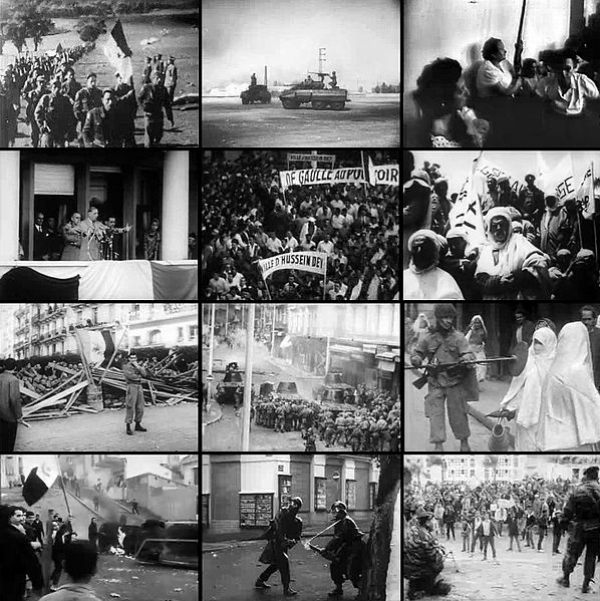1971 War: How long Distort Truth?
Total Views |
1971 Liberation War of East Pakistan continues to be celebrated as 14-day war (from 3 December 1971 to the fall of Dacca (Dhaka) on 16 December 1971) even after 47 years.
How long can the truth be distorted from future generations and deny credit to those who sacrificed their lives prior to 3 December 1971?

In contrast, books have been published by former Pakistan Army Officers covering the details of battles in East Pakistan. For example,
“History at close quarters and that its actual process is very different from what is presented to posterity” stated Sir B H Liddell Hart in his reflections compiled in “Thoughts on War” after World War 1.
Today, many media houses boast themselves tobe repository of knowledge and wisdom. Also, many academics claim “Historian Emeritus” status and find fault with the past historians for failure to record “India’s Dark Age”. Yet, none among them would like to record accurately events of 1971 War.
Year after year, media blares that the war began with preemptive aerial strikes on 3 December 1971 on 11 Indian air stations in the Western Sector. It became casus belli for launching Indian offensive into East Pakistan in support of Bangladeshi nationalist forces.
Thus media reiteration that the liberation war in East Pakistan was a 14-day war.
By field visits, historians can reconfirm sacrifices made by officers and soldiers prior to 3 December 1971 from the civilians residing astride the international border. Ironically, many gallant actions were fought well before 3 December 1971 that forced Pakistan to launch pre-emptive airstrikes.
However, the timeline of operations are available from other sources. The Time Magazine of November 1971 reported “an embarrassing victory at Boyra” in November 1971.
By not declassifying the operational reports, successive regimes have rendered disservice to the departed souls and their families. Surely, families should be extended all the benefits on par with battle casualties today.

30 years is the time frame for the release of “Top Secret” documents in democracies of the world, particularly the USA. 350 Infantry Brigade (9 Infantry Division) ordered to secure a lodgment area inside East Pakistan launched operations on night 11/12 November 1971 with 1 JAKRIF to capture the Pakistan’s MASLI BOP – EAST of Boyra salient in Jessore Sector. At the last moment, orders were received to ‘invest’ the BOP instead of capture to prevent Pakistan from capturing Indian Army prisoners (political directive) and using them to launch propaganda against Indian involvement. 45 CAV less one Squadron was deployed in support of 1 JAKRIF.
Meanwhile, on night 15 November 1971, 4 SIKH deployed NORTH of Boyra salient to provide flank security to 1 JAKRIF and to invest BARNI BOP in the North and deployed in area MAKAPUR to exploit and expand the lodgment area. By 19 November 1971, squadron 63 CAV was deployed in the area held by 4 SIKH for subsequent offensive operations. Also, one company each of 26 MADRAS deployed in area GARIBPUR and Muhammadpur to provide flank security from the Southern flank and one company to exploit and expand lodgment area up to DOSATINA.
Pakistan army launched probing patrols against the lodgments secured opposite the BOPs. Extract of debriefing of Brigadier Hayat Khan in the POW Camp in Ranchi are reproduced: “I decided to counter attack lodgment areas astride the river with one battalion which failed to evict your forces.”
Meanwhile, orders to enlarge the bridge head across River Kabadak were received with a view to build up armor and artillery deployment to support attacks on “JESSORE FORTRESS” occupied by107 Pakistan Brigade.
On night 18/19 November 1971, 102 Engineer Regiment constructed the “Krupman Bridge” over River Kabadak. Pakistan destroyed one pontoon of the bridge at 10.50 AM on 19 November 1971 with 4 x F86 Sabre fighters. Since the IAF was forbidden to cross the border, they did not pursue and engage enemy fighters over the air space inside East Pakistan.
On receipt of intelligence of withdrawal of Pak troops from BARNI post area, 4 SIKH advanced and secured all areas West of CHAUGACHA on main road leading to Jessore from North West held by Pakistan’s 38 Frontier Force Rifles.
Next, two major battles were fought on the ground and in the Air: Tank Battle of Garbipur on 21 November 1971; and air battle. Meanwhile, 14 Punjab battalion (Ex 42 Infantry Brigade) was deployed in area GARIBPUR by 3 A.M on 21 November with C Squadron 45 CAV (PT 76s) wading through the River Kabadak in support of 14 PUNJAB firm base.

On the morning of 21 November 1971, the famous tank battle of Garibpur - “Grave Yard of Tanks” - was fought. Pakistan's 107 Infantry Brigade launched a counter attack with 3rd Independent Armored Squadron after dawn. Pakistani armor rushed headlong into armor lying in wait. 11 enemy tanks were destroyed and three abandoned in condition. The destroyed Pakistani tanks were recovered and moved inside Boyra Bulge. Jagjivan Ram,
Defense Minister, addressed troops congratulating for their valor (picture featured in media).
Major D.S. Narang, Squadron Commander, known as Chefy, led the engagement personally standing with his half body outside the cupola. He was hit by enemy MMG fire and died. He was awarded Mahavir Chakra.
Next, a second Pakistani air strike was launched at 14.50 PM on 22 November 1971 with four Pakistan fighters engaging forces deployed in lodgment areas across the border. The flight of Gnats from Dum Dum appeared on the tail of hostile aircraft as they were strafing and destroyed them. Flight Lieutenant Parvez Qureshi Mehdi, who bailed out (served as the PAF Chief of Air Staff from 1997 to 2000 - during the 1999 Kargil War) was captured by 4 SIKH.
On 22 November 1971, on receipt of information of withdrawal of Pakistan troops from BOPs, troops advanced and secured all areas including Chaugacha on the road to Jessore by early morning 23 November 1971.
Finally, 350 Infantry Brigade was redeployed West and South of Jessore and 42 Infantry Brigade deployed North West astride road Chaugacha-Jessore for executing further offensive operations against “Jessore Fortress” on outbreak of war.
Thus, the true facts of the battles of 1971 Liberation War, particularly the Battle of Boyra, on the Eastern Front have been obfuscated in the Official History due to excessive obsession with “secrecy”.
Epilogue
Pakistani troops withdrew towards Khulna and put up a last ditch stand based on built-up areas. Following the unsuccessful attempt by 32 Infantry Brigade to break through Pakistani defenses in built-up area KHULNA, 350 Infantry Brigade was redeployed by 12 December 1971. The first attempt by 26 MADRAS failed which was followed by successful attacks by 1 JAKRIF and 4 SIKH that achieved significant breakthrough after fierce fighting on night 15/16 December 1971. And, the Pakistani brigade formally surrendered on 17 December 1971; and not on 16 December 1971. For the formations and troops of II Corps, 9 Infantry Division and 350 Infantry Brigade, it was a 36-day war and not a 14-day war.
Armed forces conducted operations as per political directions from time to time. The original plan of a “Rapid Thrust (Deep Penetration Thrust)” from Byra Bulge bypassing JESSORE to secure GOLONDO Ghats was changed to suit political needs.
Despite last minute political directions, units and troops responded with remarkable ability to adjust, adapt and execute crushing blow on opposing forces. And, their valor, courage and sacrifices that gained crowning victories prior to 3 December 1971 were awarded.

Yet, unfortunately the recorded history remains distorted even after 48 years. Never too late for the media houses to place the conduct of operations in erstwhile East Pakistan on all fronts accurately for posterity. Investigative journalists and historians can easily access facts given above from 1 JAKRIF and 4 SIKH. Also Gen H. S. Panag who was Adjutant, 4 SIKH is alive and staying in Chandigarh.
Also, the events have been covered in the books written by Pakistani army officers: The Vanquished Generals & The Liberation War of Bangladesh- Muntassir Mamoon; and A stranger in my own country EAST PAKISTAN 1969-71 – Major General Khadim Hussain Raja, GOC, 14 Infantry Division”.
